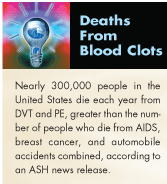Once-Weekly SC Idraparinux Equals Standard DVT Rx
A subcutaneous injection of the investigational agent idraparinux (Sanofi-Aventis) given once a week is just as effective and safe as the standard regimen of heparin plus a vitamin K antagonist in preventing recurrences of deep vein thrombosis (DVT)
agent idraparinux (Sanofi-Aventis) given once a week is just as effective and safe as the standard regimen of heparin plus a vitamin K antagonist in preventing recurrences of deep vein thrombosis (DVT), according to data presented at the American Society of Hematology 28th Annual Meeting (abstract 6). "The simplicity and efficacy of this once-weekly treatment, as opposed to the complexity of therapy with heparin and a vitamin K antagonist, is exciting news for patients at risk for this common and serious disease," said Harry R. Buller, MD, chairman of the Department of Vascular Medicine, Academic Medical Center, Amsterdam, The Netherlands.
Treatment with heparin/vitamin K antagonist requires daily injections and can have adverse interactions with food and many types of drugs. The therapy can also have a variety of results and requires intensive patient monitoring. As an alternative, Dr. Buller and fellow Van Gogh study investigators sought to assess the safety and efficacy of idraparinux, a synthetic anticoagulant, vs standard therapy in two patient populations: 2,904 patients with DVT and 2,215 patients with pulmonary embolism (PE).
Both groups were randomized to receive idraparinux 2.5 mg subcutaneously once a week or the standard daily treatment of low-molecular-weight heparin or unfractionated heparin followed by a vitamin K antagonist, for 3 to 6 months. The primary efficacy outcome was the 3-month incidence of symptomatic recurrent venous thromboembolism.

In the DVT study, the incidence of recurrence at day 92 was nearly identical in the two treatment groups: 2.9% with idraparinux vs 3% with standard treatment (odds ratio 0.98, 95% CI 0.63 to 1.50). "This result satisfied the prespecified noninferiority requirement," Dr. Buller noted.
Severe bleeding occurred in 4.5% of patients taking idraparinux and 7% of patients on heparin/vitamin K antagonist (P < .01). By 6 months, bleeding rates were similar, he reported.
The results in the PE patients were "disappointing," Dr. Buller said. The incidence of blood clot recurrence at 92 days was 3.4% in patients taking idraparinux vs 1.6% in patients on the standard regimen (odds ratio 2.14, 95% CI 1.21 to 3.78), excluding noninferiority.
"The almost double the rate of recurrences of PE seen in patients who received idraparinux vs standard therapy was a surprising finding. The patients who got standard anticoagulant therapy had an unexpectedly low recurrence rate of pulmonary embolism. We don't know why this happened," Dr. Buller said.
The Science Behind the Study
Idraparinux (Sanofi-Aventis) is a synthetic oligosaccharide. It selectively inhibits coagulation Factor Xa, interrupting the coagulation cascade at the critical point where the intrinsic and extrinsic pathways meet. Its potency and long duration of action enable it to be given as a single weekly injection.
Oncology Peer Review On-The-Go: Cancer-Related Fatigue Outcome Measures in Integrative Oncology
September 20th 2022Authors Dori Beeler, PhD; Shelley Wang, MD, MPH; and Viraj A. Master, MD, PhD, spoke with CancerNetwork® about a review article on cancer-related fatigue published in the journal ONCOLOGY®.